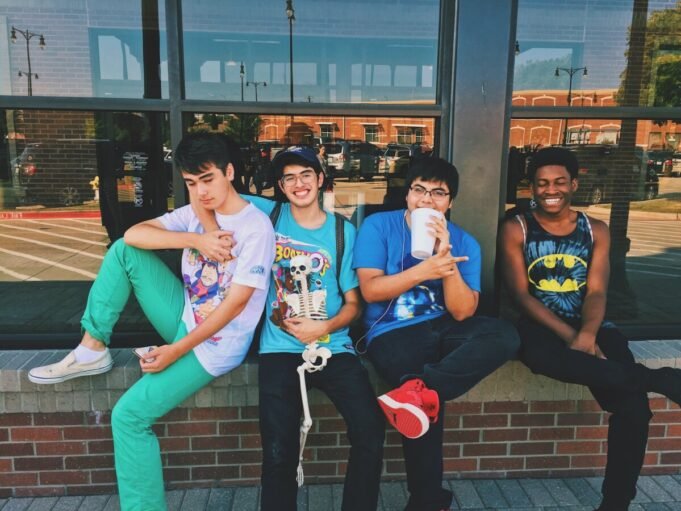Gen Z, the generation born between 1997 and 2012, is shaping the future of fashion with their unique preferences and values. This generation is known for their desire for individuality, self-expression, and sustainability in their fashion choices. They are driving the trend towards personalized fashion, embracing custom clothing and DIY projects to create styles that reflect their unique personalities and values.
Mindset and Values Driving Gen Z's Interest in Personalization
-
Individuality and Self-Expression: Gen Z values individuality and seeks to express their unique identities through their fashion choices. They reject mass-produced, cookie-cutter styles and prefer clothing that allows them to stand out and express their creativity.
-
Sustainability and Ethical Fashion: Gen Z is increasingly concerned about the environmental and social impact of the fashion industry. They are more likely to choose clothing made from sustainable materials and produced by brands that prioritize ethical practices.
-
Technology and Social Media: Gen Z is highly influenced by technology and social media. They use these platforms to discover new fashion trends, share their own styles, and connect with like-minded individuals. Social media platforms like Instagram and TikTok have become powerful tools for Gen Z to express their fashion individuality.
Custom Clothing: Embracing Unique Designs
The rise of custom clothing is a direct response to Gen Z's desire for personalized style. Online platforms and services make it easier than ever for consumers to create custom clothing items that perfectly match their preferences.
Popularity of Online Platforms and Services for Custom Clothing
-
Online Design Tools: Online platforms provide user-friendly design tools that allow consumers to create their own clothing designs from scratch or customize existing templates.
-
3D Printing and Digital Manufacturing: Advances in 3D printing and digital manufacturing technologies have made it possible to produce custom clothing items on a small scale, reducing the cost and lead time associated with traditional manufacturing methods.
-
Crowdfunding and On-Demand Production: Crowdfunding platforms and on-demand production models allow designers to test the market for their custom clothing designs before committing to full-scale production.
Brands and Designers Catering to Gen Z's Custom Clothing Preferences
-
Mass Customization: Some brands offer mass customization options, allowing consumers to personalize their clothing with unique prints, embroidery, or other design elements.
-
Made-to-Measure: Other brands offer made-to-measure services, where consumers can provide their measurements and have clothing items tailored to their exact body shape.
-
Collaborative Design: Some designers collaborate with customers to create truly unique custom clothing pieces that reflect the customer's individual style and vision.
DIY Fashion: The Creative Repurposing Approach
The DIY trend in fashion is another manifestation of Gen Z's desire for personalization and self-expression. DIY projects allow consumers to create unique clothing items using their own creativity and repurposing techniques.
Popularity of DIY Projects and Upcycling Techniques
-
Thrifting and Vintage Shopping: Gen Z consumers are increasingly turning to thrift stores and vintage shops to find unique pieces that they can repurpose into new clothing items.
-
Upcycling and Repurposing: Upcycling and repurposing techniques, such as sewing, embroidery, and dyeing, are popular ways for Gen Z consumers to transform old clothing items into new, stylish pieces.
-
DIY Fashion Tutorials and Inspiration: Social media platforms and online tutorials provide inspiration and guidance for DIY fashion projects, making it easier for consumers to create their own unique styles.
Impact of DIY Fashion Projects on Individual Style and Expression
-
Unique and Personal Style: DIY fashion projects allow consumers to create clothing items that are truly unique and reflective of their individual style.
-
Cost-Effective and Sustainable: DIY projects can be a cost-effective way to create new clothing items, and they also promote sustainability by reducing waste and extending the lifespan of existing clothing.
-
Creative Outlet and Skill Development: DIY fashion projects provide a creative outlet for Gen Z consumers and allow them to develop new skills in sewing, design, and repurposing.
DIY Fashion: The Creative Repurposing Approach
Popularity of DIY Projects and Upcycling Techniques
Gen Z consumers are embracing DIY fashion projects and upcycling techniques as a way to personalize their style, express their creativity, and reduce their environmental impact.
-
Thrifting and Vintage Shopping: Gen Z consumers are increasingly turning to thrift stores and vintage shops to find unique pieces that they can repurpose into new clothing items. This trend is driven by a desire for individuality and a rejection of mass-produced fashion.
-
Upcycling and Repurposing: Upcycling and repurposing techniques, such as sewing, embroidery, and dyeing, are popular ways for Gen Z consumers to transform old clothing items into new, stylish pieces. This trend is driven by a desire for sustainability and a creative outlet.
-
DIY Fashion Tutorials and Inspiration: Social media platforms and online tutorials provide inspiration and guidance for DIY fashion projects, making it easier for consumers to create their own unique styles. This trend is driven by the desire to learn new skills and express individuality.
Impact of DIY Fashion Projects on Individual Style and Expression
DIY fashion projects allow Gen Z consumers to create clothing items that are truly unique and reflective of their individual style. This trend is driven by a desire for self-expression and a rejection of mass-produced fashion.
-
Unique and Personal Style: DIY fashion projects allow consumers to create clothing items that are truly unique and reflective of their individual style. This trend is driven by a desire for self-expression and a rejection of mass-produced fashion.
-
Cost-Effective and Sustainable: DIY projects can be a cost-effective way to create new clothing items, and they also promote sustainability by reducing waste and extending the lifespan of existing clothing. This trend is driven by a desire for affordability and sustainability.
-
Creative Outlet and Skill Development: DIY fashion projects provide a creative outlet for Gen Z consumers and allow them to develop new skills in sewing, design, and repurposing. This trend is driven by a desire for creativity and self-expression.
Impact on the Fashion Industry
Gen Z's personalization preferences are having a significant impact on the fashion industry, challenging traditional business models and creating new opportunities for innovation.
Challenges and Opportunities Presented by Gen Z's Personalization Preferences
-
Challenges:
-
Mass Production vs. Customization: The shift towards personalized fashion poses a challenge for traditional fashion brands that rely on mass production.
-
Supply Chain Complexity: Meeting the demand for personalized fashion requires a more complex supply chain, which can be difficult to manage efficiently.
-
Cost and Time: Customizing clothing items can be more expensive and time-consuming than mass production.
-
-
Opportunities:
-
New Business Models: The demand for personalized fashion is creating opportunities for new business models, such as online platforms that connect consumers with designers and manufacturers.
-
Innovation in Design and Manufacturing: The need to meet Gen Z's personalization preferences is driving innovation in design and manufacturing technologies, such as 3D printing and digital manufacturing.
-
Sustainability: The focus on personalization and DIY fashion is promoting sustainability in the fashion industry by reducing waste and extending the lifespan of clothing items.
-
How Fashion Brands Are Adapting to Meet Gen Z's Demand for Personalization
Fashion brands are adapting to meet Gen Z's demand for personalization in a number of ways:
-
Offering Customization Options: Some brands offer customization options, allowing consumers to personalize their clothing with unique prints, embroidery, or other design elements.
-
Collaborating with Designers: Other brands are collaborating with designers to create limited-edition collections that cater to Gen Z's desire for unique and personalized fashion.
-
Investing in Technology: Some brands are investing in technology to improve their ability to produce personalized clothing items efficiently and cost-effectively.
-
Embracing Sustainability: Many brands are embracing sustainability as a way to appeal to Gen Z consumers who are increasingly concerned about the environmental and social impact of the fashion industry.



































